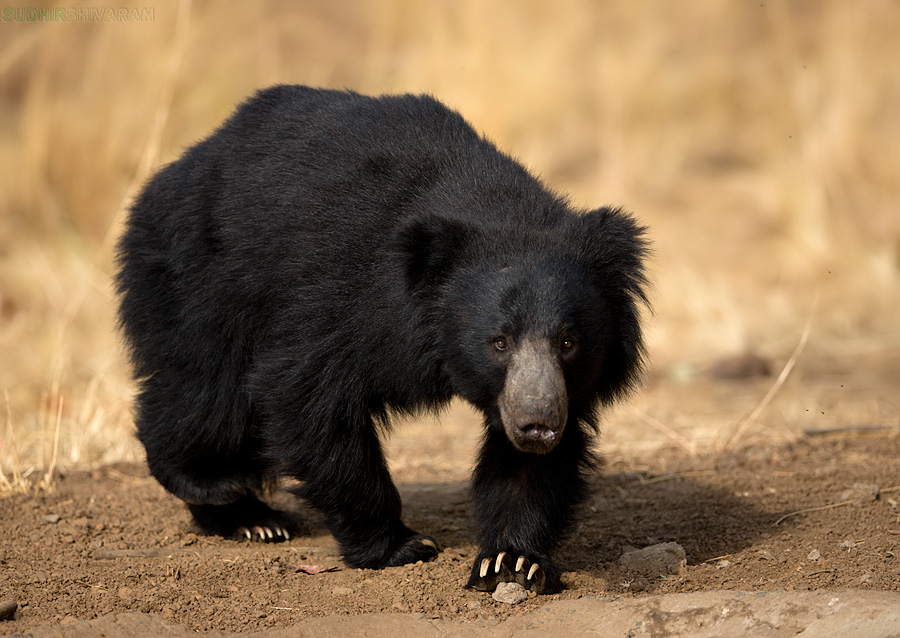Post by Deleted on Feb 19, 2014 22:25:48 GMT 5
Giant Panda - Ailuropoda melanoleuca
The giant panda, or panda (Ailuropoda melanoleuca, literally meaning "black and white cat-foot") is a bear native to central-western and south western China. It is easily recognized by its large, distinctive black patches around the eyes, over the ears, and across its round body. Though it belongs to the order Carnivora, the panda's diet is 99% bamboo. Pandas in the wild will occasionally eat other grasses, wild tubers, or even meat in the form of birds, rodents or carrion. In captivity they may receive honey, eggs, fish, yams, shrub leaves, oranges, or bananas along with specially prepared feed. The giant panda lives in a few mountain ranges in central China, mainly in Sichuan province, but also in the Shaanxi and Gansu provinces. The giant panda has a black-and-white coat. Adults measure around 1.2 to 1.8 meters (4 to 6 ft) long, including a tail of about 13 cm (5.1 in), and 60 to 90 centimeters (1 ft 10 in to 2 ft 10 in) tall at the shoulder. Males can weigh up to 160 kilograms (350 lb). Females (generally 10–20% smaller than males) can weigh as little as 75 kg (170 lb) but can also weigh up to 125 kilograms (280 lb). Average adult weight is 100 to 115 kilograms (220 to 250 lb).

Sloth Bear - Melursus ursinus
The sloth bear, also known as the labiated bear, is a nocturnal insectivorous species of bear found wild within the Indian subcontinent. The sloth bear evolved from ancestral brown bears during the Pleistocene and shares features found in insect-eating mammals through convergent evolution. The population isolated in Sri Lanka is considered as a subspecies. Unlike brown and black bears, sloth bears have lankier builds, long shaggy coats that form a mane around the face, long sickle shaped claws, and a specially adapted lower lip and palate used for sucking insects. Sloth bears breed during spring and early summer and give birth near the beginning of winter. They feed on termites, honeybee colonies and fruits. Sloth bears sometimes attack humans that encroach on their territory. Adult sloth bears weigh 100 kg (220 lbs) on average, though weight can range variously from 55 kg (121 lbs) to 190 kg (400 lbs). They are 60–90 cm (2–3 ft) high at the shoulder, and have a body length of 1.4–1.9 m (4.6–6.3 ft).

The giant panda, or panda (Ailuropoda melanoleuca, literally meaning "black and white cat-foot") is a bear native to central-western and south western China. It is easily recognized by its large, distinctive black patches around the eyes, over the ears, and across its round body. Though it belongs to the order Carnivora, the panda's diet is 99% bamboo. Pandas in the wild will occasionally eat other grasses, wild tubers, or even meat in the form of birds, rodents or carrion. In captivity they may receive honey, eggs, fish, yams, shrub leaves, oranges, or bananas along with specially prepared feed. The giant panda lives in a few mountain ranges in central China, mainly in Sichuan province, but also in the Shaanxi and Gansu provinces. The giant panda has a black-and-white coat. Adults measure around 1.2 to 1.8 meters (4 to 6 ft) long, including a tail of about 13 cm (5.1 in), and 60 to 90 centimeters (1 ft 10 in to 2 ft 10 in) tall at the shoulder. Males can weigh up to 160 kilograms (350 lb). Females (generally 10–20% smaller than males) can weigh as little as 75 kg (170 lb) but can also weigh up to 125 kilograms (280 lb). Average adult weight is 100 to 115 kilograms (220 to 250 lb).

Sloth Bear - Melursus ursinus
The sloth bear, also known as the labiated bear, is a nocturnal insectivorous species of bear found wild within the Indian subcontinent. The sloth bear evolved from ancestral brown bears during the Pleistocene and shares features found in insect-eating mammals through convergent evolution. The population isolated in Sri Lanka is considered as a subspecies. Unlike brown and black bears, sloth bears have lankier builds, long shaggy coats that form a mane around the face, long sickle shaped claws, and a specially adapted lower lip and palate used for sucking insects. Sloth bears breed during spring and early summer and give birth near the beginning of winter. They feed on termites, honeybee colonies and fruits. Sloth bears sometimes attack humans that encroach on their territory. Adult sloth bears weigh 100 kg (220 lbs) on average, though weight can range variously from 55 kg (121 lbs) to 190 kg (400 lbs). They are 60–90 cm (2–3 ft) high at the shoulder, and have a body length of 1.4–1.9 m (4.6–6.3 ft).










